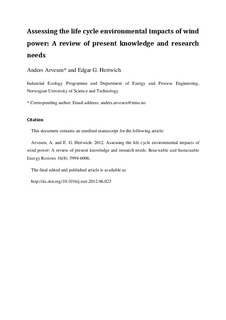Assessing the life cycle environmental impacts of wind power: A review of present knowledge and research needs
Journal article, Peer reviewed
Permanent lenke
http://hdl.handle.net/11250/297942Utgivelsesdato
2012Metadata
Vis full innførselSamlinger
Originalversjon
Renewable and sustainable energy reviews 2012;16(8):5994-6006 10.1016/j.rser.2012.06.023Sammendrag
We critically review present knowledge of the life cycle environmental impacts of wind power. We find that the current body of life cycle assessments (LCA) of wind power provides a fairly good overall understanding of fossil energy use and associated pollution; our survey of results that appear in existing literature give mean values (± standard deviation) of, e.g., 0.060 (±0.058) kWh energy used and 19 (±13) g CO2e emitted per kWh electricity, suggesting good environmental performance vis-à-vis fossil-based power. Total emissions of onshore and offshore wind farms are comparable. The bulk of emissions generally occur in the production of components; onshore, the wind turbine dominates, while offshore, the substructure becomes relatively more important. Strong positive effects of scale are present in the lower end of the turbine size spectrum, but there is no clear evidence for such effects for MW-sized units. We identify weaknesses and gaps in knowledge that future research may address. This includes poorly understood impacts in categories of toxicity and resource depletion, lack of empirical basis for assumptions about replacement of parts, and apparent lack of detailed considerations of offshore operations for wind farms in ocean waters. We argue that applications of the avoided burden method to model recycling benefits generally lack transparency and may be inconsistent. Assumed capacity factor values are generally higher than current mean realized values. Finally, we discuss the need for LCA research to move beyond unit-based assessments in order to address temporal aspects and the scale of impacts.
